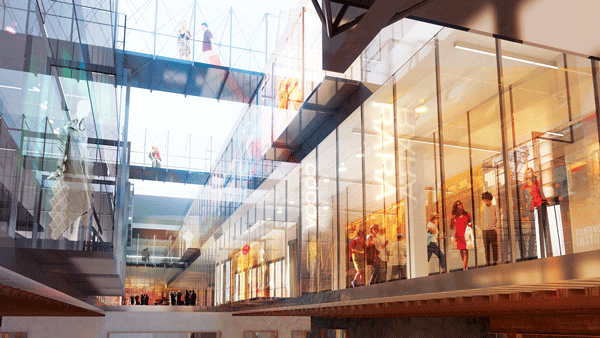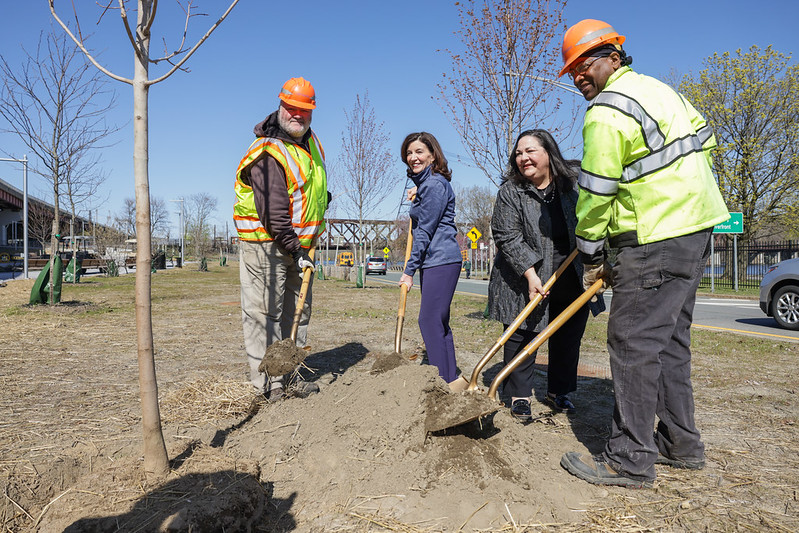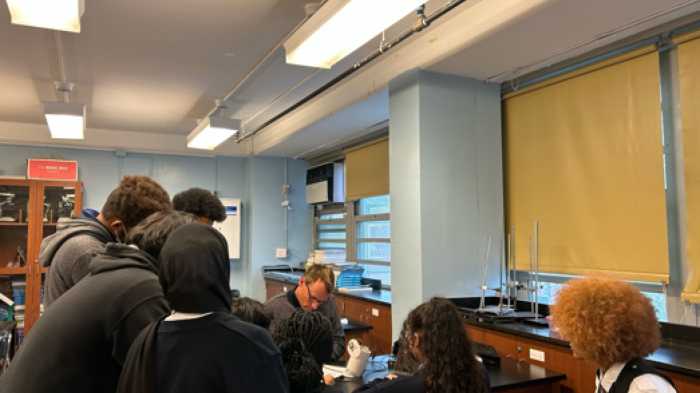
BY ALINE REYNOLDS | Starting next year, workers will begin building a street-like network of shops overlooking the East River, so long as the swanky design by the Howard Hughes Corporation wins approval from various city agencies.
Officials representing Howard Hughes Corp., the leaseholder of the South Street Seaport, and the company’s commissioned firm, SHoP Architects, presented a revised design of the substantial Pier 17 overhaul to Community Board 1 at a meeting earlier this month. While the design won praise among local residents, business owners and workers union representatives, some testifiers raised serious concerns about the plan, particularly with regard to the developer’s rezoning proposal and future maritime use at the pier.
C.B. 1 has until Tues., Nov. 13 to review the Uniform Land Use Review and Procedure application for Pier 17. Board members will convene another couple of times to continue to assess the proposal with the goal of preparing a finalized resolution for its Thurs., Nov. 8 Executive Committee meeting. Following the board’s review, the ULURP will be reviewed by Manhattan Borough President Scott Stringer, the City Planning Commission and, finally, by the City Council.
Pier 17’s overall redesign, which was mostly sanctioned by the city Landmarks Preservation Commission and C.B. 1 last spring, features a street-like network of retail shops and a 65-foot-high rooftop with a restaurant, an entertainment venue and 40,000 square feet of public space offering panoramic views of the harbor and the Brooklyn Bridge. More than 46 percent of the property will be publicly accessible waterfront space — including 32,000 square feet of yardage to the north of the future shopping center. A 63-foot-long cutout will reference the original configuration of Piers 17 and 18 as two separate piers. The project is set for completion in 2015.
According to the latest design proposal, the building will be divided into two floor plates, which will allow natural sunlight to filter in and reach the ground-floor level. “When it rains, the rain will come right down through the middle of the building,” said Gregg Pasquarelli, a partner at SHoP Architects. “We think it will really have this great engagement of the waterfront.”
The Link Building, adjoined to the pierside mall, was also redesigned so that it doesn’t obstruct the view from the pier of the neighboring Tin Building. According to the latest design, the refurbished Link Building, which will consist of transparent glass doors, will house a fresh food market run by local produce operators. And, if the designers get the necessary approvals, Fulton Plaza, the open decking area at the foot of Fulton Street, will have a permanent performance stage whose programming may synchronize with the pier’s rooftop entertainment.
Howard Hughes Corp. is requesting a change in the zoning of the pier and the surrounding historic district in order to enable a broader range of retail use at the future pier and make the zoning consistent with that of the southward section of the East River waterfront.
According to the developer, the existing C-28 zoning is a vestige of the Manhattan Landing Plan, which dates back to the early 1970s and features concentrated clusters of housing along the waterfront. The proposed mix of retail, the development proposal says, will “serve to complement the growing residential and worker populations in the area by catering more to the tastes of local residents and workers.”
C.B. 1 members eagerly inquired about a master plan for the South Street Seaport, which would entail a redevelopment of the area surrounding Pier 17. But Chris Curry, Howard Hughes Corp.’s senior executive vice president of development, gave the same reply he has given in recent months: “The project before you stands on its own,” he said, adding, “The objective is to make an immediate investment in the Seaport while providing an iconic experience unlike anything else in the city.” Additional redevelopment plans for the neighborhood would require further ULURP action that would undergo city vetting.
The lack of a master plan provoked C.B. 1 Planning Committee Chair Jeff Galloway and other board members to question the need for a rezoning of the entire district. “I would be reluctant to talk about zoning changes for something where we’d have no idea for what’s going to [be there],” said Galloway.
The Historic Districts Council, which testified at the C.B. 1 meeting, also opposed Howard Hughes’s application to rezone the entire district — saying, “Rezoning should only come after specific plans have met all the other necessary approvals.”
However, the City Planning Commission — tasked with reviewing the plan before it is sent to City Council — would prefer a neighborhood-wide rezoning proposal to one that would only alter the zoning regulations of Pier 17, according to Paul Selver, an attorney representing Howard Hughes Corp. “It’s an easier map to administer when it doesn’t have another district there stuck in at some place,” he said.
Vessel operators and maritime advocates voiced anxiety about the amount of docking space at the pier once it is renovated. Southbridge Towers resident Tom Berton, president of Manhattan By Sail, said the overhaul would jeopardize the operations of Clipper City, an 1854 sailing vessel that has been moored at Pier 17 for four years and that takes an estimated 50,000 New Yorkers into the harbor each year.
Were construction to begin on June 30, 2013, as planned, Clipper City would have its docking rights terminated by the end of 2012, according to Berton. The ship could cease operations altogether if Manhattan By Sail doesn’t find a suitable alternative docking space to the pier by then. Berton is therefore asking Howard Hughes Corp. to postpone the start date to Sept. 30, 2013.
“It doesn’t make any sense for affected local businesses or for the community to have to lose such valuable public space in the middle of the busy summer season,” said Berton. “It is only three months, but it would make a world of difference to the community, and to the jobs and people that enjoy the Seaport during the warm summer months.”
Susan Henshaw Jones, director of the Museum of the City of New York, which is currently overseeing the museum’s operations, opposes the Pier 17 redesign, in part due to the overly commercial nature of the proposed pier structure. “This overemphasis on commercial street activity directly undermines the goals of the historic district and is plainly contrary to the vision and requirements of all plans for the Seaport District,” she said. “Needless to say, any museum would have a difficult time operating in this type of environment.”
The Seaport Museum is also requesting to expand its commercial use at Pier 16 — where its ship, the Ambrose, is docked — and to expand its programming in the water separating Piers 15 and 16. The latter space, according to Jones, serves as an important access point for the Wavertree, another ship owned by the museum. “The Seaport Museum’s legal right to utilize the apron for waterfront events activities should be explicitly acknowledged by the Economic Development Corporation, [the site’s owner],” she said, “and we seek the community board’s support regarding this.”
Margaret Flanagan, representing the Historic Ships Coalition, slammed Howard Hughes’ request for a special permit that would allow the developer to circumvent the pier’s current waterfront zoning regulations that restrict the size of retail at pier establishments. Structural changes to the dock, she said, could interfere with mooring at the site. “Specifically, the [proposal] acknowledges that ships used to berth at Pier 17’s north side, but proposed changes reconfigure that edge to make it sloped, and thus generally unsuitable for docking ships in the future,” said Flanagan.
But Pasquarelli countered that the docking layout would minimally change the pier’s current amenability to ship mooring. A small section of the docking area would be altered to make way for a handicap-accessible ramp, he said, acknowledging that it would therefore be difficult to dock at that edge of the pier.
“We absolutely want to encourage vessels to be able to moor at Pier 17,” Pasquarelli said.
Asked why the docking configuration wasn’t referenced in the officials’ latest presentation of the design to C.B. 1, he said, “We’re not to the point where we would make those kinds of drawings in that kind of detail.”
Locals also voiced concern about Howard Hughes’ plans for signage at the pier — which, according to the proposal, comprises one illuminated, nine-foot-high sign on the roof that says “Seaport” and up to 18 smaller, unlit signs bearing the names of the retail stores that will be mounted on the building’s facades. Contrary to locals’ concerns, the signs, which require Landmarks Preservation Commission approval, would be appropriate for the pier’s redesign and would not detract from the pier visitors’ views of the harbor, according to the ULURP.
Community members are nevertheless worried the signs could be changed in the future into unwanted advertisements. “C.B. 1 voted against this in 1984, the content of the letters not being challengeable once it’s created so it could later down the road read ‘SONY’ or whatever,” noted Southbridge Towers resident Paul Hovitz, a member of C.B. 1’s Seaport/Civic Center Committee.
But, according to Selver, City Planning would prevent the developer from altering the sign in the future without the department’s consent — assuming the signage is authorized to begin with.
Several people extolled the Pier 17 plan for its innovative design and visitor-friendly amenities. Tom Brown, vice president of production and operations at Little Airplane Productions, a production company located on Front Street, is in full support of the redesign. “I can’t tell you how happy my staff is to be able to go [to Pier 15] and sit and have lunch,” he said, “and I can only imagine how they’ll feel when this place is open.”
South Street resident Amanda Byron Zink, owner of the Salty Paw, a pet shop at 38 Peck Slip, voiced support of the makeover — adding that she could count on both hands the number of times she and her family have shopped at Pier 17’s current mall. “I feel my front yard is one of the most beautiful waterfronts in the world, and probably one of the most wasted and under-utilized New York City neighborhoods as it stands now,” she said.
Bernard Callegari, representing Construction and General Building Laborers’ Local 79, happily announced that the Pier 17 project should generate 350 union construction jobs. The union construction industry, he noted, was hit very hard by the economic downturn. “These jobs are going to real people that I speak to daily, some of whom are losing their houses,” he said.
“This project returns a tarnished jewel of the neighborhood to the status it deserves.”

































